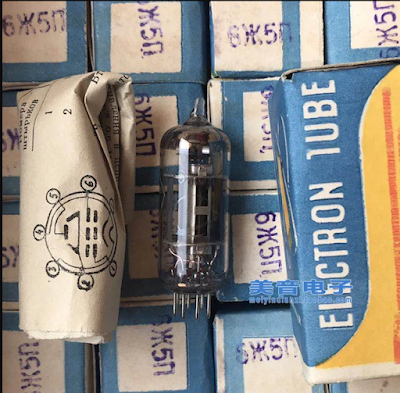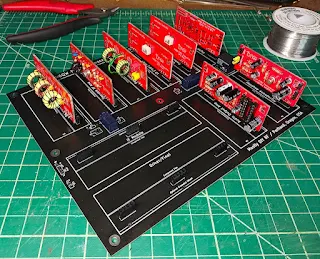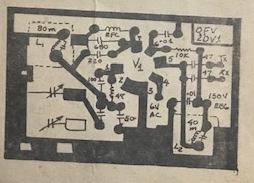Pavel CO7WT explained why Cuban hams used a process of thermal endurance to improved the frequency stability of their homebrew rigs:
--------------------
I'm CO7WT from Cuba, I started my endeavor in ham radio with a islander board.
They (FRC, like ARRL but in Cuba) made a print of a PCB to build the Islander, with component numbers and values, making construction fool proof, I think it was on the 90 or end of the 80...
Mine was built with scraps from an old KRIM 218 Russian B&W TV as Coro's explain, later on I get the 6bz6 and 6be6 tubes for the receiver (this worked better than the Russian parts) the VFO was transistorized, made with Russian components. A friend CO7CO Amaury, explain me a trick: thermal endurance:
For a week put a crust of ice on the VFO board by placing it in a frosty fridge during the night. Put them in the sun by day. This indeed improved stability, this was an old trick.
By thermal endurance I
mean improving thermal resistance vs tolerance, meaning that tolerance doesn't
vary as much with temperature changes.
I remember that my vfo was on 7 MHz, with Russian kt315 as normal Russian transistors and capacitors, nothing 1-5%, 20% at most, it ran several khz in 5-10 min, mounted on a Russian "Formica" board (no PCB) and wired underneath.
After that treatment to the complete board with components and everything, including the variable capacitor; I managed to get it to "only" noticeably in the ear after 30-40 minutes.
To me it was magic!!
Basically, what I'm describing is just "thermal annealing", but Cuban-style and with more extreme limits.
In a refrigerator you could easily reach -10 c and in the sun for a day in Cuba 60-80 celsius at least.
In Cuba in the 1990s-2010s many designs of DSB radios proliferated, both direct conversion and super heterodine (using an intermediate frequency)
At first tubes and then transistors, mostly using salvaged parts, so it was common to find 465/500 kHz (if common Russian) 455 khz and 10.7 Mhz with or without "wide" filters since narrow filters for SSBs were not scarce: they were almost impossible to get.
Not only that, crystals, ifs, PCBs, transistors, etc.
Then, around the 2000s, Russian 500 khz USB filters began to appear (from Polosa, Karat, etc. equipment from companies that deregistered and switched to amateur radio) and that contributed to improving... Even though at 7 MHz 500kc if is very close.
I made many modifications with the years mostly from 1998 to 2004 ish... better filters in front of the first RX stage (same IF described between stages) improved selectivity and out of band rejection, remember we had on that days broadcast as low as 7100 khz
Tx part was a pair of russian 6P7 (eq. RCA 807) in paralell, etc.
The Jagüey and others is one of those evolutions...
73 CO7WT
----------------
This is not as crazy as it sounds. We can find versions of the same technique in the writings of Roy Lewellan W7EL, Doug DeMaw W1FB, and Wes Hayward W7ZOI. I found this 2007 message from our friend Farhan VU2ESE:
I think the word 'annealing' is a bit of a misnomer. the idea is to thermally expand and contract the wiring a few times to relieve any mechanical stresses in the coil. after an extreme swing of tempuratures, the winding will be more settled.
this techniques owes itself to w7EL. I first read about it in his article on the 'Optimized transceiver' pulished in 1992 or so.
but all said and done, it is part of the lore. it needs a rigorous proof.
- farhan
And here is another example of coil boiling:
https://www.qsl.net/kd7rem/vfo.htm
-----------
I can almost hear it, all the way from across the continent: Pete N6QW should, please, stop chuckling. Obviously these stabilization techniques are not necessary with his beloved Si5351. Some will see all this as evidence of the barbarity and backwardness of LC VFOs. But I see it as another example of lore, of art in the science of radio. (Even the FCC regs talk about "Advancing the radio art." ) This is sort of like the rules we follow for LC VFO stability: keep the frequency low, use NP0 or silver mica caps, use air core inductors, keep lead length short, and pay attention to mechanical stability. Sure, you don't have to do any of this with an Si5351. Then again, you don't have to do any of this to achieve stability in an Iphone. But there is NO SOUL in an Iphone, nor in an Si5351. Give me a Harley, a Colpitts, or a Pierce any day. But as I try to remember, this is a hobby. Some people like digital VFOs. "To each, his own."
Thanks Pavel.













.jpg)











(co6ec) Jose de Jesus Enriquez Campos
The first Image was the prototype presented at the Ganuza meeting, the rest of the photos were the ones we built with the improvements, and the photos and plans were sent to many colleagues, the colleagues who went to that meeting will remember, well, they still have to there are many left, because that was almost 30 years ago,
greetings CO6EC
(co8zz) Raul Verdecie
Magnificent photographs!!!... They seem to have been taken today with some digital "super camera"!!!
Really, from what I can see now, the CO6EC Islander was the perfect example... mine (my first radio and built by me) was also made like this, with the plates that the FRC sold and it was good, but very ugly ...HI... The AGC worked wonderfully as it came, I don't know if Jose's improvements were later! With it I made my first hundred or so entities only in 40 meters / CW (between 7,100 and 7,150) when it was CL8ZZ. I gave it away so that someone would have their license and now I regret not having kept it... I would have liked to show it now to those who regret not having a radio!!!
(co8zz) Raul Verdecie
Ah, I can never forget those headphones!!!... my external hearing aids (read ears) are much smaller today thanks to them, they exerted tons of force on the operators' skulls!!!
(cm6vml) Vidal
Very good article, I hope that one day, with a good teacher, I can build my own team, congratulations Jose, regards Vidal.
(co7wt) Pavel Milanes (CO7WT)
Sure...
My first radio and with which I got my CL7WT license back in the 90's an ISLANDER, like that in capital letters.
I remember that the CL only had a small 40m segment (like now) and that it was full of broadcasts as soon as the afternoon fell, it was an odyssey to speak on the radio... you had to find a "little hole" between the Broadcastings where it wouldn't bother you " a lot" to be able to talk.
I remember that the old CO7OC (he is no longer a radio amateur) and CL7HU (now AC7HU) helped me build it with a board I bought at the radio club. I took almost all the valves from the deceased KRIM 218, then I found a store in Camagüey that sold idle things from the workshops...
Turns out they had such a large inventory of "idle" tubes that they couldn't put it on the counter...they let me through to the warehouse...huge...stack of tubes, if I remember correctly I ended up with Chinese or Japanese tubes that they were more sensitive in the receiver... the driver went from a 6P14P to a more robust 6P9, by the end that was a humble 6P44 it became two 6P7s that were a Russian version of the RCA 607 if I remember correctly... in the end it had like 80W.
It goes without saying that when I said on the radio that there were valves in that place "they flew"....
The VFO was the one from the Jagüey, not the original from the Islander, I never knew about the AGC modifications.
I would like if someone has the plans with the modifications to send them to me, just for nostalgia...
My email pavelmc@gmail.com
(co2jc) Carlos Alberto Santamaría González
Brother, your article is very good, because of the nostalgia and also because it talks about what we radio amateurs like: tinkering. I didn't have an Islander because what I started with in 2000 was a Polosa to which two colleagues helped me adapt it with VFO for 40 and 80 m. But I talked a lot with colleagues who did it with an Islander or a Jagüey and participated in the Rueda del Behique that I started in the 80 m. Others in the Hurricane Wheel that started a little later and were heard well. As you well say, the propagation at that time had nothing to do with what it is now, but it was very good to listen to the colleagues who came out with the equipment they had built. Thank you once again for your article. CO2JC